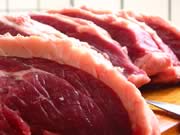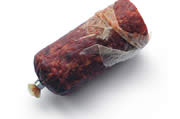Meat & fish
Before the start of agriculture ca. 10,000 years B.C., the killing of animals for food reasons was one of the most important social activities of the pre-historical human being. Even now, some tribes in Tanzania and Australia live on hunting and fishing.
Although a small, but increasing % of the population switches over for ethical reasons to meat replacers (vegetarian products), meat and meat products still take in a special position for nutritional and socio-cultural reasons.
1. Meat is an excellent source of high quality protein that contains all the essential amino acids necessary for physical well-being and for proper mental and intellectual development. It also contains large amounts of minerals (iron, magnesium) and essential B-vitamins. In this latter respect, it is one of the few good sources of vitamin B12.
2. Throughout recorded history, the consumption of meat has indicated a position of social and economic prestige. As a nation industrializes, its meat consumption increases. As persons raise their social or economic status, they tend to demand a greater and higher quality of meat products.
The average meat consumption of a today EU-citizen amounts 94,7 kg per capita, while this quantity is largely exceeded in the with an average consumption of 120 kg per capita. In the EU, 49 % of the meat consumed is pork, followed by poultry (24,5 %), beef/calf (22 %) and sheep/goat (4 %).
In 2005, the EU meat production amounted about 37 million of tons, and it is expected that amount will further increase the coming years.
Fish is consumed since the prehistorical Homo sapiens, and even now some people mainly live on a diet of fish. In the EU, the consumption of fish is promoted for healthy reasons. Oily fish (Macherel, Herring, Sardines) contain Omega-3 fatty acids, a type of polyunsaturated fat which can help to reduce total blood cholesterol. They are also important in brain development. Moreover, sea food contains an abundance of essential minerals like iron, zinc, iodine and selenium. Fish is also acting as a good source of vitamins and protein.
The average fish consumption is the EU amounts 17 kg per capita. Usually, prices for fish are higher than for meat and poultry.
Composition of Lean Muscle Tissue
|
Species |
Composition (%) |
|||
|
Water |
Protein |
Lipid |
Ash |
|
|
Beef Pork Chicken Lamb Cod Salmon |
70-73 68-70 73,7 73 81,2 64 |
20-22 19-20 20-23 20 17,6 20-22 |
4-8 9-11 4,7 5-6 0,3 13-15 |
1 1,4 1 1,6 1,2 1,3 |
Degree of Saturation of Fatty Acid Components of Lipid from Muscle Tissue of Various Species
|
Species |
Fatty acids (%) |
||
|
Saturated |
Monenoic |
Polyenoic |
|
|
Beef Pork Mutton Poultry Cod (lean fish) Mackerel (fatty fish) |
40-71 39-49 46-64 28-33 30 30 |
41-53 43-70 36-47 39-51 22 44 |
0-6 3-18 3-5 14-23 48 26 |
 naar boven
naar boven


 bedrijven
bedrijven



